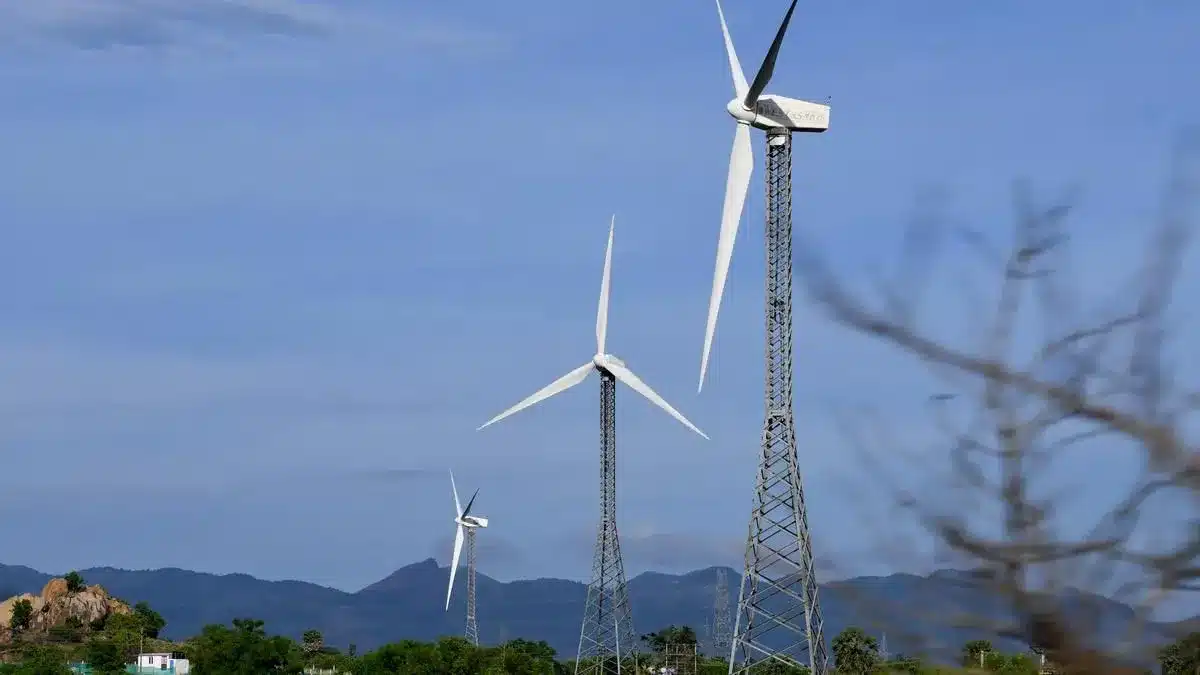What’s in today’s article?
- Introduction
- Current Wind Energy Capacity in India and Tamil Nadu
- Understanding Repowering and Refurbishment of Wind Turbines
- Challenges with the New Policy and Industry Opposition
- Tamil Nadu’s Repowering Potential and the Way Forward
Introduction
- Tamil Nadu has long been a pioneer in wind energy generation in India, with its first wind turbines installed over 30 years ago.
- Recently, the Tamil Nadu government introduced the “Tamil Nadu Repowering, Refurbishment, and Life Extension Policy for Wind Power Projects – 2024” to modernize aging wind turbines and improve efficiency.
- However, the policy has faced opposition from wind energy generators who claim it does not effectively support wind energy growth.
- Here’s a closer look at the current status of wind energy in Tamil Nadu and the challenges involved in boosting its capacity.
Current Wind Energy Capacity in India and Tamil Nadu
- National Potential: According to the National Institute of Wind Energy (NIWE), India has a wind power potential of 1,163.86 GW at a height of 150 meters, making it one of the top countries globally for wind energy capacity.
- Installed Capacity: Currently, India uses only about 6.5% of its potential wind energy capacity. Tamil Nadu, with 10,603.5 MW of installed capacity, ranks second in India and contributes significantly to the national wind power production.
- Aging Infrastructure: Tamil Nadu has around 20,000 wind turbines, half of which are less than 1 MW in capacity, making them less efficient compared to modern turbines.
Understanding Repowering and Refurbishment of Wind Turbines
- Repowering:
- This involves replacing old turbines, especially those over 15 years old or with a capacity of less than 2 MW, with new, higher-capacity turbines to increase output.
- For instance, a 2 MW turbine requires 3.5 acres and can generate up to 6.5 million units of power annually, while a modern 2.5 MW turbine, standing at 140 meters, requires five acres and can generate around 8 million units.
- Refurbishment:
- This process includes upgrading components such as turbine blades, gearboxes, and increasing the height of turbines to improve efficiency without complete replacement.
- Life Extension:
- Involves implementing safety and structural upgrades on older turbines to extend their operational life.
Challenges with the New Policy and Industry Opposition
- Wind energy generators have raised several concerns regarding the new policy, leading them to approach the Madras High Court, which has temporarily halted its implementation.
- The main issues include:
- Land Requirements for Higher Capacity Turbines: Upgrading to larger turbines, like 2.5 MW models, requires more land, which is not always available near existing installations.
- Infrastructure Delays: Projects aimed at enhancing transmission infrastructure, such as the construction of sub-stations, have faced delays. At Aralvaimozhi, a high-potential site, plans for new sub-stations have stalled for six years, impacting the ability to harness maximum wind energy from the area.
- Banking Restrictions: The policy treats repowered turbines as new installations, which makes them ineligible for the banking of generated energy. Without banking facilities, the financial viability of these projects is reduced, as producers cannot store excess energy for future use.
Tamil Nadu’s Repowering Potential and the Way Forward
- Tamil Nadu has the highest repowering potential among Indian states, with over 7,000 MW of capacity that could be repowered or refurbished.
- Experts estimate that by upgrading smaller turbines, wind energy contributions during peak seasons could increase by 25%.
- However, stakeholders in the industry feel that the policy should address field-level challenges and financial constraints to make repowering more attractive. For example:
- Field-Level Solutions: Generators are calling for policies that consider practical challenges such as land acquisition, infrastructure requirements, and community concerns around newer, taller turbines.
- Financial Viability: Many investors, especially those from industries such as textiles that rely on renewable energy, are unwilling to invest in wind energy projects unless they are financially viable. The current policy does not provide enough commercial incentives to encourage these investments.
Q1. What is the UNFCCC and what do they do?
The UNFCCC secretariat (UN Climate Change) is the United Nations entity tasked with supporting the global response to the threat of climate change. UNFCCC stands for United Nations Framework Convention on Climate Change.
Q2. What is the difference between mitigation and adaptation?
In essence, adaptation can be understood as the process of adjusting to the current and future effects of climate change. Mitigation means preventing or reducing the emission of greenhouse gases (GHG) into the atmosphere to make the impacts of climate change less severe.
Last updated on December, 2025
→ Check out the latest UPSC Syllabus 2026 here.
→ Join Vajiram & Ravi’s Interview Guidance Programme for expert help to crack your final UPSC stage.
→ UPSC Mains Result 2025 is now out.
→ UPSC Notification 2026 is scheduled to be released on January 14, 2026.
→ UPSC Calendar 2026 is released on 15th May, 2025.
→ The UPSC Vacancy 2025 were released 1129, out of which 979 were for UPSC CSE and remaining 150 are for UPSC IFoS.
→ UPSC Prelims 2026 will be conducted on 24th May, 2026 & UPSC Mains 2026 will be conducted on 21st August 2026.
→ The UPSC Selection Process is of 3 stages-Prelims, Mains and Interview.
→ UPSC Result 2024 is released with latest UPSC Marksheet 2024. Check Now!
→ UPSC Prelims Result 2025 is out now for the CSE held on 25 May 2025.
→ UPSC Toppers List 2024 is released now. Shakti Dubey is UPSC AIR 1 2024 Topper.
→ UPSC Prelims Question Paper 2025 and Unofficial Prelims Answer Key 2025 are available now.
→ UPSC Mains Question Paper 2025 is out for Essay, GS 1, 2, 3 & GS 4.
→ UPSC Mains Indian Language Question Paper 2025 is now out.
→ UPSC Mains Optional Question Paper 2025 is now out.
→ Also check Best IAS Coaching in Delhi

















